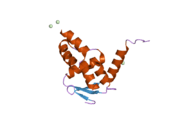ZBTB7A
Zinc finger and BTB domain-containing protein 7A is a protein that in humans is encoded by the ZBTB7A gene.[5][6][7]
Interactions
See also
References
- 1 2 3 GRCh38: Ensembl release 89: ENSG00000178951 - Ensembl, May 2017
- 1 2 3 GRCm38: Ensembl release 89: ENSMUSG00000035011 - Ensembl, May 2017
- ↑ "Human PubMed Reference:".
- ↑ "Mouse PubMed Reference:".
- ↑ Morrison DJ, Pendergrast PS, Stavropoulos P, Colmenares SU, Kobayashi R, Hernandez N (Apr 1999). "FBI-1, a factor that binds to the HIV-1 inducer of short transcripts (IST), is a POZ domain protein". Nucleic Acids Res. 27 (5): 1251–62. doi:10.1093/nar/27.5.1251. PMC 148309. PMID 9973611.
- ↑ Davies JM, Hawe N, Kabarowski J, Huang QH, Zhu J, Brand NJ, Leprince D, Dhordain P, Cook M, Morriss-Kay G, Zelent A (Feb 1999). "Novel BTB/POZ domain zinc-finger protein, LRF, is a potential target of the LAZ-3/BCL-6 oncogene". Oncogene. 18 (2): 365–75. doi:10.1038/sj.onc.1202332. PMID 9927193.
- ↑ "Entrez Gene: ZBTB7A zinc finger and BTB domain containing 7A".
- ↑ Davies JM, Hawe N, Kabarowski J, Huang QH, Zhu J, Brand NJ, Leprince D, Dhordain P, Cook M, Morriss-Kay G, Zelent A (January 1999). "Novel BTB/POZ domain zinc-finger protein, LRF, is a potential target of the LAZ-3/BCL-6 oncogene". Oncogene. 18 (2): 365–75. doi:10.1038/sj.onc.1202332. PMID 9927193.
Further reading
- Bonaldo MF, Lennon G, Soares MB (1997). "Normalization and subtraction: two approaches to facilitate gene discovery". Genome Res. 6 (9): 791–806. doi:10.1101/gr.6.9.791. PMID 8889548.
- Pendergrast PS, Wang C, Hernandez N, Huang S (2002). "FBI-1 Can Stimulate HIV-1 Tat Activity and Is Targeted to a Novel Subnuclear Domain that Includes the Tat-P-TEFb—containing Nuclear Speckles". Mol. Biol. Cell. 13 (3): 915–29. doi:10.1091/mbc.01-08-0383. PMC 99609. PMID 11907272.
- Lee DK, Suh D, Edenberg HJ, Hur MW (2002). "POZ domain transcription factor, FBI-1, represses transcription of ADH5/FDH by interacting with the zinc finger and interfering with DNA binding activity of Sp1". J. Biol. Chem. 277 (30): 26761–8. doi:10.1074/jbc.M202078200. PMID 12004059.
- Strausberg RL, Feingold EA, Grouse LH, et al. (2003). "Generation and initial analysis of more than 15,000 full-length human and mouse cDNA sequences". Proc. Natl. Acad. Sci. U.S.A. 99 (26): 16899–903. doi:10.1073/pnas.242603899. PMC 139241. PMID 12477932.
- Pessler F, Hernandez N (2003). "Flexible DNA binding of the BTB/POZ-domain protein FBI-1". J. Biol. Chem. 278 (31): 29327–35. doi:10.1074/jbc.M302980200. PMID 12750370.
- Laudes M, Christodoulides C, Sewter C, et al. (2004). "Role of the POZ zinc finger transcription factor FBI-1 in human and murine adipogenesis". J. Biol. Chem. 279 (12): 11711–8. doi:10.1074/jbc.M310240200. PMC 4303998. PMID 14701838.
- Beausoleil SA, Jedrychowski M, Schwartz D, et al. (2004). "Large-scale characterization of HeLa cell nuclear phosphoproteins". Proc. Natl. Acad. Sci. U.S.A. 101 (33): 12130–5. doi:10.1073/pnas.0404720101. PMC 514446. PMID 15302935.
- Liu CJ, Prazak L, Fajardo M, et al. (2004). "Leukemia/lymphoma-related factor, a POZ domain-containing transcriptional repressor, interacts with histone deacetylase-1 and inhibits cartilage oligomeric matrix protein gene expression and chondrogenesis". J. Biol. Chem. 279 (45): 47081–91. doi:10.1074/jbc.M405288200. PMID 15337766.
- Gerhard DS, Wagner L, Feingold EA, et al. (2004). "The Status, Quality, and Expansion of the NIH Full-Length cDNA Project: The Mammalian Gene Collection (MGC)". Genome Res. 14 (10B): 2121–7. doi:10.1101/gr.2596504. PMC 528928. PMID 15489334.
- Maeda T, Hobbs RM, Merghoub T, et al. (2005). "Role of the proto-oncogene Pokémon in cellular transformation and ARF repression". Nature. 433 (7023): 278–85. doi:10.1038/nature03203. PMID 15662416.
- Lee DK, Kang JE, Park HJ, et al. (2005). "FBI-1 enhances transcription of the nuclear factor-kappaB (NF-kappaB)-responsive E-selectin gene by nuclear localization of the p65 subunit of NF-kappaB". J. Biol. Chem. 280 (30): 27783–91. doi:10.1074/jbc.M504909200. PMID 15917220.
- Olsen JV, Blagoev B, Gnad F, et al. (2006). "Global, in vivo, and site-specific phosphorylation dynamics in signaling networks". Cell. 127 (3): 635–48. doi:10.1016/j.cell.2006.09.026. PMID 17081983.
- Roh HE, Lee MN, Jeon BN, et al. (2007). "Regulation of Pokémon 1 activity by sumoylation". Cell. Physiol. Biochem. 20 (1–4): 167–80. doi:10.1159/000104164. PMID 17595526.
External links
- ZBTB7A+protein,+human at the US National Library of Medicine Medical Subject Headings (MeSH)
- FactorBook ZBTB7A
This article incorporates text from the United States National Library of Medicine, which is in the public domain.
This article is issued from
Wikipedia.
The text is licensed under Creative Commons - Attribution - Sharealike.
Additional terms may apply for the media files.









